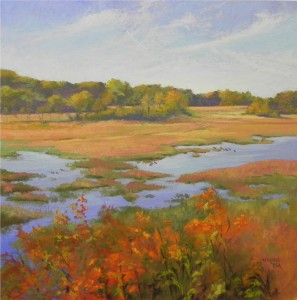This is another painting with a challenging foreground (see Working with Reds). I’ve always found the foreground to be one of the primary problems faced by the landscape painter. Given aerial perspective, the foreground is often the place with the strongest darks and most vibrant colors. But we want the viewer to look at the entire painting and not get trapped in the foreground. So how to make this work? I began this painting working slowly at the top, using direct applications of Ludwig and Great American pastels on UArt 400 grit paper without an underpainting. I really enjoyed doing it all until I got to the bottom, which I left for another day! My first solution was to get up at 4:30AM–a fearless time when I am totally focused! I decided to do an underpainting in the lower part that would make it easier for me to place the leaves and branches over it. I used the same Ludwig pastels (light applications) and alcohol. Then I took the bright red orange, orange, yellow orange, and yellow green pastels and worked very quickly to develop a pattern and not get too picky. I also added a very dark brown (a color I hardly ever use). I tried to used the upper branches to lead the eye into the upper right of the painting. I then used some of the duller warm Ludwigs that I’d used in the background to tone it down and fill in. Finally, I used some of the bright orange in small amounts in the distant trees to tie in the color. I think this works. The strong foreground color grabs the eye, then, I hope, leads us into the background waterway and distant fields. Compositionally, I consider this to be a big shape painting. It’s about the V-shape of water with land around it, with no one strong center of interest. I did add little groupings of ducks to provide more interest. But it’really about shape and flow and color.

